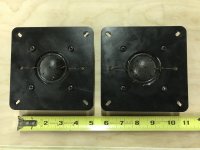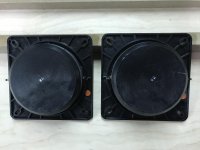Early Peerless were made in Denmark. ADS tweeters were made by Braun of Germany.
I wont hedge any bets, but I think these are Magnat tweeters made by Braun.
I wont hedge any bets, but I think these are Magnat tweeters made by Braun.
Yes! I bet you are right. The ADS L1290 (good speaker in it's day)... google the image and it looks like the midrange is the same as the OP's pic.
I have a pair of L880's, they & the L1290's (and others in that line) used a 2" mid-dome that was clear-ish in color, no holes. I haven't handled any (late 70's-early 90's) A/D/S domes that were plastic, metal only. None from other Braun, or HECO either for that matter- but my experience is far from comprehensive. I have zero knowledge of Magnat drivers.
The holes in the fabric should be a telltale clue for someone. Polk did that early on with their 1" Peerless domes, a single hole top center, IIRC.
The holes in the fabric should be a telltale clue for someone. Polk did that early on with their 1" Peerless domes, a single hole top center, IIRC.
Thanks again for the replies. Searching google images has not produced a match so I'm wondering if there is a thread that outlines a step by step way of testing these to find out some basic specifications? I tried searching "testing tweeters" but came up with nothing useful to a novice.
Any suggestions?
Any suggestions?
If I were starting with an unknown tweeter:
1) Start with an impedance sweep. I have DATSv3, but there are other ways of doing it. I would expect a 1.5 inch dome to have an Fs of 400 to 800 hz. Other than that the impedance should be smooth. Abrupt jumps are a bad sign.
2) Do a frequency response measurement. I would use cardboard or foam board to make a baffle of about 26 x 36 inch. I use Omnimic, but REW and a cheap USB mic will do the job also. The FR should look reasonable, it should look like something I could work with.
3) I would make harmonic distortion measurements. I like odd order HD to be less than 1% in the pass band. 2nd order HD can be a little higher at perhaps 2%... but lower is better.
1) Start with an impedance sweep. I have DATSv3, but there are other ways of doing it. I would expect a 1.5 inch dome to have an Fs of 400 to 800 hz. Other than that the impedance should be smooth. Abrupt jumps are a bad sign.
2) Do a frequency response measurement. I would use cardboard or foam board to make a baffle of about 26 x 36 inch. I use Omnimic, but REW and a cheap USB mic will do the job also. The FR should look reasonable, it should look like something I could work with.
3) I would make harmonic distortion measurements. I like odd order HD to be less than 1% in the pass band. 2nd order HD can be a little higher at perhaps 2%... but lower is better.
If I were starting with an unknown tweeter:
1) Start with an impedance sweep. I have DATSv3, but there are other ways of doing it. I would expect a 1.5 inch dome to have an Fs of 400 to 800 hz. Other than that the impedance should be smooth. Abrupt jumps are a bad sign.
I have a Smith & Larson Woofer Tester 2 that I have used on some woofers but have not tried it on a tweeter yet.
2) Do a frequency response measurement. I would use cardboard or foam board to make a baffle of about 26 x 36 inch. I use Omnimic, but REW and a cheap USB mic will do the job also. The FR should look reasonable, it should look like something I could work with.
I have a good mike and preamp, what is a good software to use for the FR?
3) I would make harmonic distortion measurements. I like odd order HD to be less than 1% in the pass band. 2nd order HD can be a little higher at perhaps 2%... but lower is better.
I have no clue how to do HD measurements, what equipment and software do I need?
A lot of people like REW software. It is free. It will do gated frequency response measurements and harmonic distortion measurements.
REW - Room EQ Wizard Room Acoustics Software
REW - Room EQ Wizard Room Acoustics Software
- Home
- Loudspeakers
- Multi-Way
- Help ID Dome Tweeters

